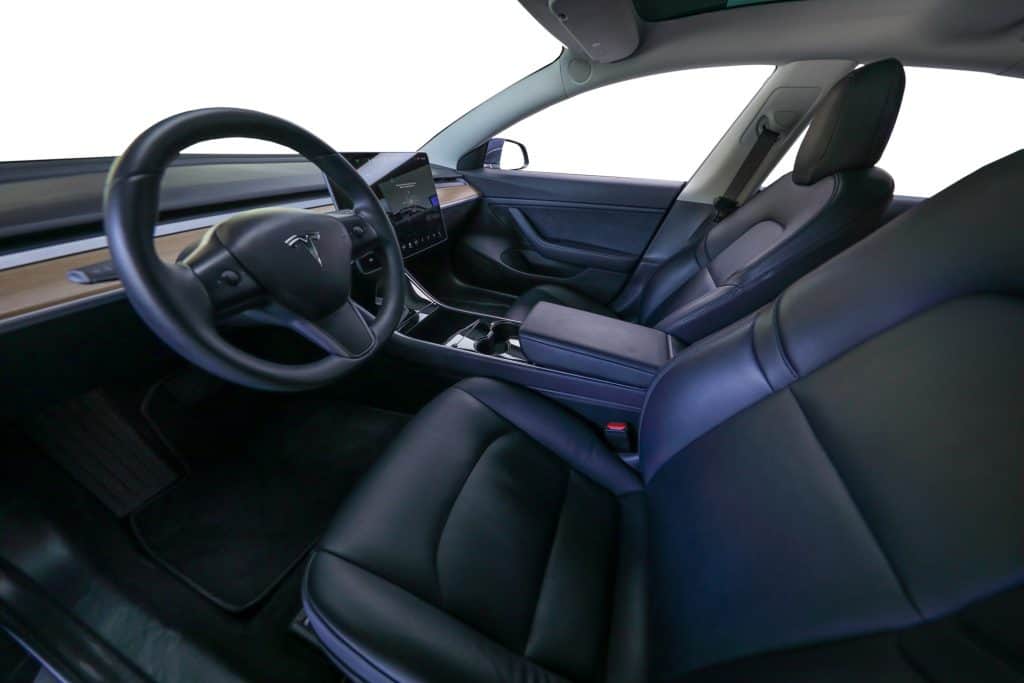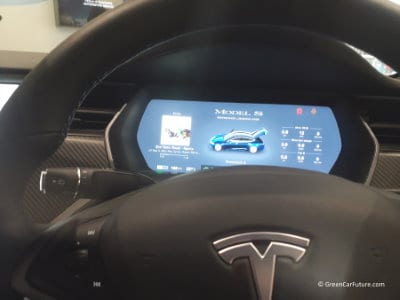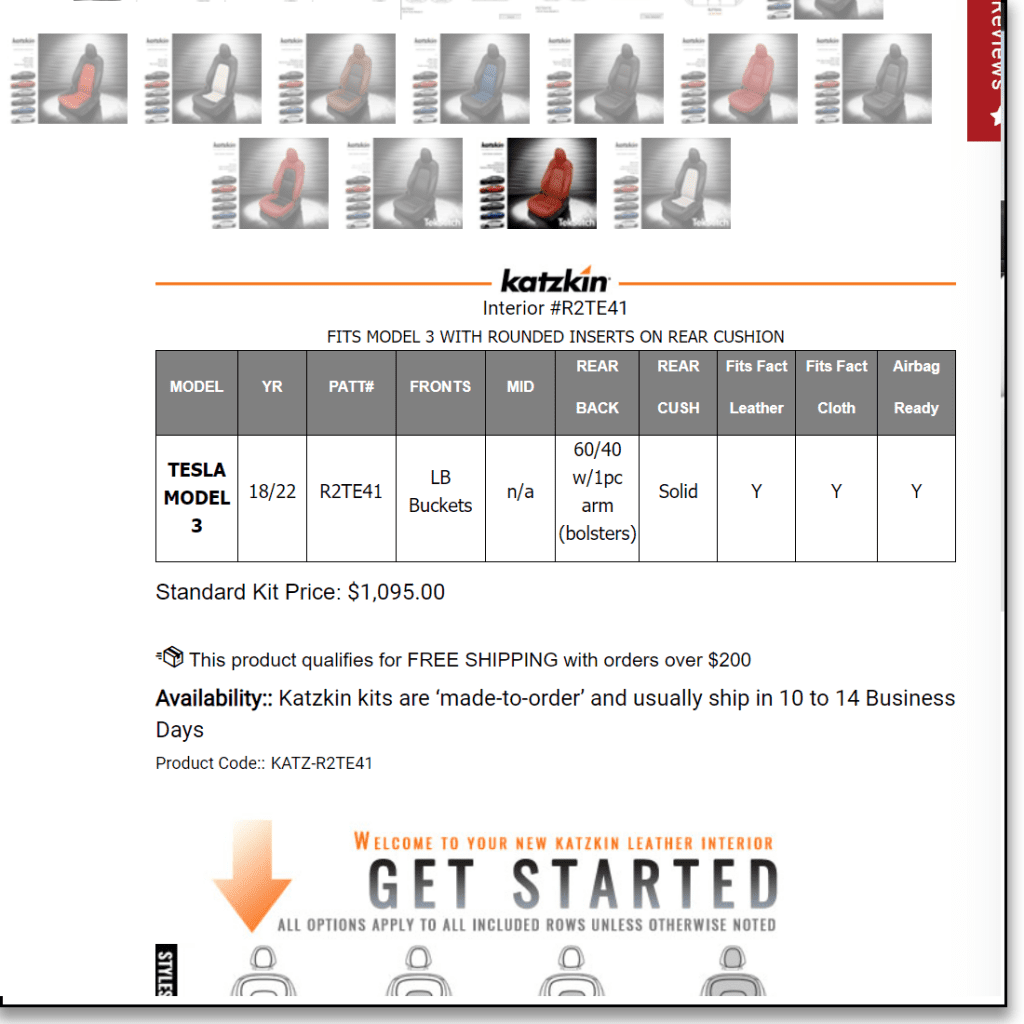Back in 2015 at a Tesla stockholders’ meeting, animal rights pressure group PETA started lobbying Tesla to make their cars “vegan” by ridding them of all animal-based leather in the car’s interior. At the time, the stockholders voted against this proposition, but in the subsequent few years, discussions continued and in 2017 and 2019 the group started to see successful results.
PETA is actually a stockholder in Tesla, too, so it’s not hard to understand why it is they are particularly and publicly urging Tesla to make this change over other automakers. We assume, however, that they feel the same way about all car interior leather.
2017: The First Transition Occurs
The first move away from leather interiors was reported back in July 2017, but it had been put in place in 2016. At the time, USA Today reported that Tesla’s environmentally friendly cars were also now “vegan-friendly” because all premium interior options were now to be completely leather free. The only exception at the time was the steering wheel, which continued to be leather wrapped unless a specific request was made.
The first application of the new material came in the Model X. The leather-free material is a synthetic non-animal seating material based on polyurethane that was actually designed and manufactured specifically for Tesla cars. PETA pointed out that Tesla was already behind some other car makers like BMW, who had already started offering faux leather in their range.
While fans of traditional leather may mourn the loss, many pointed to the benefits of the synthetic material that go beyond animal welfare. Not only is the polyurethane material used just as robust as real leather, but it’s even more stain-resistant. It’s also incredibly pliable, which helps to extend its life.
Of course, those who wanted a Tesla but were also concerned for animal welfare were never forced to take the leather option. Tesla has always provided fabric upholstery as a standard option in their models. The leather interior was and remains a premium option for which you have to specify when you order.
USA Today also noted in 2017 that Tesla made these changes “quietly” and without any public fanfare. At the time, there was also no public announcement as to whether the changes would apply to the then new Tesla Model 3. The leather-free option applied then to the Model S and Model X, although Musk did indicate on Twitter that the leather-free option would be there for the Model 3, too.
PETA’s intention was to pressure Tesla to adopt the vegan-friendly animal-free leather across its entire range before 2019. At the same time, they wanted to make sure Tesla dropped real leather as an option entirely.
2019: The Tesla Model 3 Joins the Leather-Free Club

By the end of August 2019, it seemed that PETA was meeting its goals as their invested company Tesla announced that the new Model 3 was now entirely leather-free. As you’ll gather from the section above, the synthetic polyurethane material was not exactly news in 2019, but what was news was the interior being 100-percent free from animal-based leather.
Many of the steering wheels had still been leather-wrapped in Tesla models unless buyers made a specific request about that. The Model X and Model S cars had this option, but the Model 3 had been outside of that. Until 2019, it was actually impossible to get the Model 3 without the leather-wrapped steering wheel. That was the big change by August 2019. The Model 3, and thus the entire Tesla range, had now become leather-free.
Second-Hand Teslas
Some problems remain, however. Since not everyone out there can afford to buy a brand-new Tesla, some opt for pre-owned models. The question, then, is how could a concerned buyer be sure that the Tesla they were buying with a premium interior was made from the Tesla synthetic material, and not from leather?
Given the quality of the new material, many have pointed to their inability to really tell the difference between the two. Being able to know for sure applies equally to those who are determined to stick to their animal-free principle and those who are determined to have real leather at all costs.
Look at the Model Year

The first clue you’ll have to confirm whether the interior is real or synthetic leather is to look at the model year. If the car is from 2017 or later, and has a premium interior, then there’s a very good chance it’s a synthetic leather model.
Tesla started making the change back in 2016, although they didn’t make any big song and dance about it. The only thing that might be difference in post-2017 models is the steering wheel. You can be confident that the upholstery is synthetic, but the wheel will depend on the buyer’s initial request.
If you’re buying a Model 3, then it could be more complicated. The Model 3 was released in 2017, but the interior wasn’t confirmed as fully vegan-friendly until 2019. Remember that while the Model 3 had the option of the synthetic leather premium interior, the wheel was exempt from that, and remained leather-wrapped until 2019. To ensure you have a fully leather-free Tesla Model 3, you’ll have to purchase one from at least the 2019 model year onwards.
Get a Custom Upholstery Job
Whether you do it to change a real leather interior to something synthetic, or vice versa, there are many options for drivers who want to make a change to their Tesla upholstery. Many have already opted to make the change from 2015 onwards because they noticed even after a short time, there was more wear and tear on the leather or fabric upholstery than they wanted, and Tesla was unwilling to fix it, not seeing it as a warranty issue.
Fans of real leather might turn to providers like shopsar.com, who specialize in installing premium Katzkin leather upholstery to Tesla’s, promising a look and feel as good as or better than when it rolled off the production line. Katzkin leather is genuine top-grain aniline-dyed leather from Brazil. They should be enough to slake the thirst of any driver keen to restore the prestige that one often feels from “proper” leather.
A Model 3 “standard seat kit” from shopsar is currently listed as $1,095, a fairly cheap option compared to a full seat change – but naturally this is more of a seat cover than a seat replacement:

Another provider is tsportline.com, who offer a huge range of Italian leather and suede options, as well as custom themes, lights and steering wheel options. The fact is, then, that there is a market out there for those wanting to make a change to their Tesla interior. Whichever direction you want to take the interior fabrics, it seems you can do it via these third-party providers. Custom jobs can easily cost more than $10,000 depending on the total number of seats you have recovered. A 7-seat configuration at tsportline.com, for example, costs $14,000.
See the Vehicle Specifications
If you’re buying a second-hand Tesla, then the current owners should have a full set of specifications for it. You can ask to see those before you buy, and it should specify the exact materials used for the interior.
Conclusion: Leather or PU – Have Your Tesla Any Way
Tesla has yielded to the demands of its shareholders by going vegan-friendly with its leather interiors, but it is by no means alone in this. By all reports, the synthetic leather material used in Tesla cars is a decent alternative to traditional leather. On top of that, it has a long lifespan, and is stain-resistant and easier to clean and car for. That’s a big plus when you’ve already spent a lot on the car itself.
What’s more, Tesla customers who want to modify their interior can do so. If you have the money to spend, you can get really sumptuous and decadent interiors in real or faux leather, suede and other materials, which you can then augment with interior ambient lighting and more. Who knew that Tesla’s were so versatile?
As it turns out, Tesla owners can have their vegan-friendly cake and eat it, too (or not).